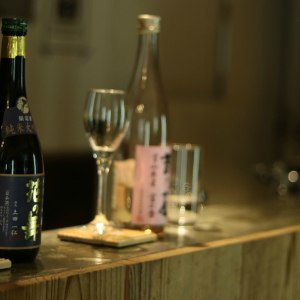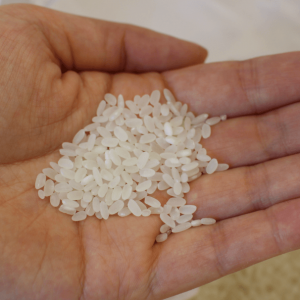
In addition to selling by the bottle, some sake retailers also offer their wares in-store by the glass, typically at a standing counter or table. In Japanese, this serving style is called kaku-uchi (角打ち). A great way to compare and contrast styles, kaku-uchi is recently growing in popularity again.
What’s in a name?
The term kaku-uchi contains two kanji characters: kaku (角), meaning “edge” or “corner,” and uchi (打ち), meaning to hit or strike. But just what does this have to do with sake?
According to one theory, the etymology of this term is connected to the masu, a square wooden serving vessel traditionally used to measure and serve sake.
In Japan’s Edo Period (1603-1867), sake was typically sold by measure using these masu. In a precursor to the modern day “bring-your-own” concept, sake drinkers would bring their own serving bottles to be filled at the store. Originally, the masu was only used to measure and pour sake, not to drink from.
However, some sake fans were not content to take just one variety home — they wanted to sample the other brews on offer. For these curious connoisseurs, sake stores began offering smaller quantities of sake to be consumed on the premises straight out of the masu.
The Japanese word for “square” is shi-kaku (四角), literally “four corners,” and sake drinkers would place the “edge” or “kaku” of this square box to their mouths, hence the term “kaku-uchi.”
Coming out of Kyushu
The roots of modern kaku-uchi are said to lie in Northern Kyushu.
At the turn of the 20th century, an industrial district sprang up in the northern region of Japan’s southern island, precipitated by the creation of the publicly-run Yahata Steelworks in 1901. Workers toiled around the clock on a 24-hour shift system. This left those on the night shift with nowhere to go for an after-work tipple, as all the bars were closed by morning.
Sake stores, however, were open for business, which led to a proliferation of in-store drinking. Continuing this tradition, kaku-uchi remains popular in Northern Kyushu today, with around 150 sake stores offering drinks to thirsty patrons.
Later, in the mid-1960s, a newly constructed steelworks in Chiba, just east of Tokyo, enticed many of these workers to migrate from Kyushu to eastern Japan. They brought the culture of kaku-uchi with them, and from there the practice spread throughout the entire country.
The appeal of simplicity
Taking place away from the confines of stuffy restaurants, Kaku-uchi is notable for its casual simplicity. Patrons stand rather than sit, and if snacks are served, they tend to be basic canned or dried foods.
This is part of the appeal. The drinks are affordable, and because sake stores usually carry a wide selection, this makes kaku-uchi ideal for exploring new varieties of sake.
Kaku-uchi is an excellent, cost-effective way to broaden one’s sake horizons. Kaku-uchi is in something of a second boom period now, and is a great way for travelers and sake enthusiasts to try a lot of flavors in one convenient stop. There are even retailers innovating on the concept with coin operated sake sample dispensers for in-store imbibing – no Japanese required.
*If you would like us to send you monthly updates and information, register here.





Comments